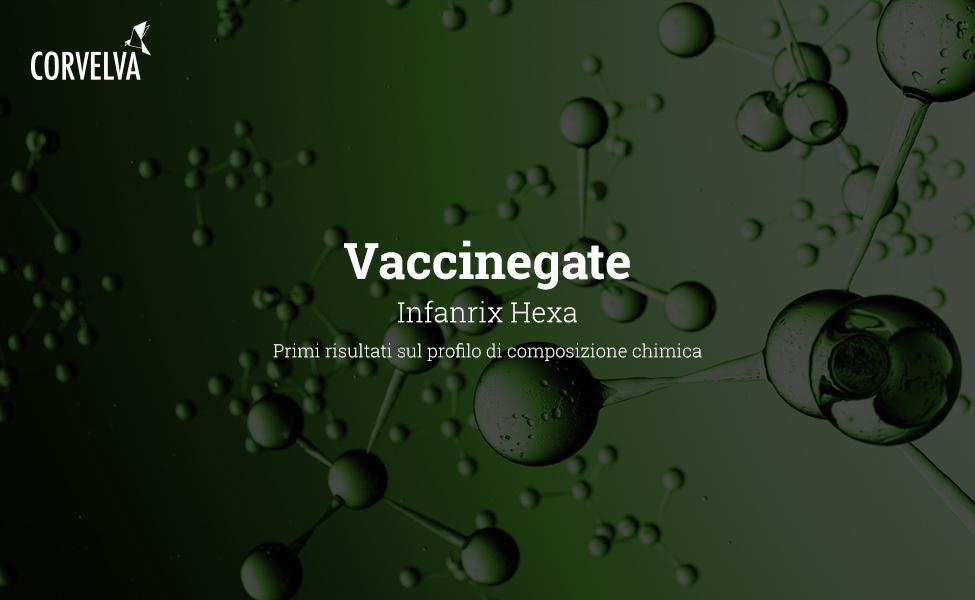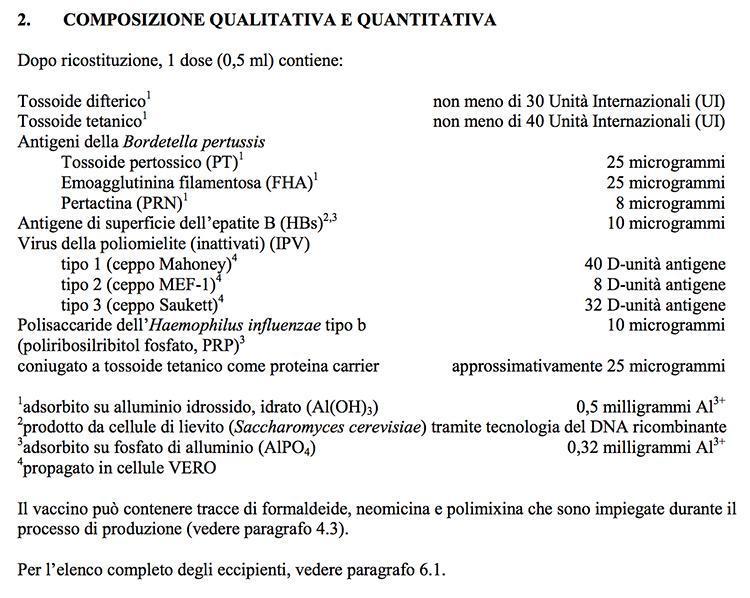First results on the chemical composition profile Infanrix Hexa

We describe some points that concern us, we anticipate that when we started these analyzes, from metagenomics to current chemistry, we had many questions and were only looking for answers ... with the first results we have even more questions and above all concerns!
The qualitative-quantitative investigation of organic compounds is of great importance in the pharmacological field. There are potential safety problems arising from new production processes and the complex structural and biological characteristics of the products.
It follows that the following were found in the vaccine:
- Chemical contaminations from the manufacturing process or from cross-contamination with other production lines
- Chemical toxins
- Bacterial peptide toxins
- Insoluble and indigestible macromolecule that reacts to the protein test but is not recognized by protein databases
The presence of:
- Protein antigens of diphtheria toxoids, tetanus, pertussis, hepatitis B, Haemophylus influenzae B, Poliomyelitis 1-2-3
- Formaldehyde and glutaraldehyde, phenoxyethanol, antibiotic residues indicated in the composition
There are six antigens present in the Infanrix Hexa vaccine: the tetanus toxides, diphtheria and pertussis, the D antigens of the three poliomyelitis viruses, the proteins obtained by genetic engineering for hepatitis B and the polysaccharides of the haemophylus chemically linked to the tetanus toxoid as carrier. To form toxoids a treatment with formaldehyde and glutaraldehyde is necessary which should allow to eliminate toxicity while maintaining their ability to stimulate protective antibodies against the original toxins.
What we expected to find were the three toxoids and the other antigens that were not modified by formaldehyde and glutaraldehyde treatments, separable from each other and digestible by the specific enzyme for proteins (trypsin). Instead, a real polymer, insoluble and indigestible, was found, consisting of the set of chemically linked antigens (to be defined if present as an aggregate of the individual antigens or a single macromolecule), on which information is also found in the literature for individual antigens. 1-2
This macromolecule has not been recognized in any way by protein databases, and therefore in fact turns out to be a solid compound of unknown chemical structure.
The solubility of proteins and the possibility of digesting them (i.e. cutting them into small peptide fragments) are the two typical characteristics of proteins, which allow us not to study them with the methods for the analysis of proteins but also they are a necessary requirement for interaction with the immune system for the formation of protective antibodies, because if the structure of a protein is profoundly modified compared to the original one, even the antibodies that are formed are completely different from those that are able to attack the original antigens that cause diseases.
Since this polymer we encountered, derived from the mix of antigens, is not only different from the point of view of the spatial conformation but above all it is different from the chemical point of view, we can say that we are not in the presence of antigens similar to the original ones but to a compound with unknown and unpredictable toxicity and efficacy.
In addition to the fact that vaccine antigens were not actually detected, 65 signals of chemical contaminants were found of which 35% are known, that is, recognized by comparison with the databases; among these we find various processing residues, and cross-contamination from other production lines, the identification of which will be verified in the second level analytical analysis (i.e. with control standards).
Among these signals, 7 chemical toxins have also been identified, probably originating from the antigen processing process or from other production processes present at the vaccine production site; these toxins not yet clearly defined in the structure seem to derive in part from the reaction of formaldehyde, glutaraldehyde, and cyanogen bromide with other chemical contaminants present in the vaccine. It is emphasized that most of these toxins have an established and published toxicity in Pubchem 3 or Toxnet 4 e pose a significant security problem.
Various free peptides (i.e. short fragments of amino acid chains) of bacterial origin resulted from the study of the protein and peptide fraction, which therefore come from bacterial culture cells for the extraction of antigens. Bacterial peptides are reported in the literature as potential allergens 5 and capable of inducing autoimmune reactions 6 and these also pose a safety issue that will need to be clarified with regulatory agencies.
Returning to the two main pillars that made us begin this path of analysis and reiterating the concept expressed by recent interview in the prestigious scientific journal Nature: we are investigating the efficacy and safety of vaccines and in reality it is difficult to understand how it is possible to say that this vaccine is able to form protective antibodies against the six diseases for which we protect ourselves and it is even more difficult to understand how it can be established that this cluster is not toxic in infants since it is a matter of 6 neurotoxic antigens linked together.
The hexavalent Infanrix hexa, for the method we commissioned, leaves enormous doubts both on its effectiveness and on its safety ...
We assure you of one thing: we will not stop.
Download: CORVELVA-Report-analysis-composition-chemical-Infanrix-Hexa.pdf
References
- J Chromatogr B Analyt Technol Biomed Life Sci. 2017 Jun 1; 1054: 80-92 - The combined use of analytical tools for exploring tetanus toxin and tetanus toxoid structures.
- Vaccines. 2007 Mar 8; 25 (12): 2213-27. - Investigation of the detoxification mechanism of formaldehyde-treated tetanus toxin.
- https://pubchem.ncbi.nlm.nih.gov/search/
- https://toxnet.nlm.nih.gov/
- Int J Med Microbiol. 2018 Aug; 308 (6): 738-750. - The quest for bacterial allergens.
- Front Microbiol. 2017 Oct 9; 8: 1938 - Morbid Sequences Suggest Molecular Mimicry between Microbial Peptides and Self-Antigens: A Possibility of Inciting Autoimmunity.
Insights
The Infanrix Hexa vaccine has the following composition, we faithfully copy from the present technical data sheet manufacturer's data sheet:

The antigen preparation shown below is that indicated in the EMA report for the marketing authorization of Infanrix Hexa. 1
Diphtheria toxoid: Diphtheria toxoid is obtained by inactivating the toxin (produced by Corynebacterium diphtheriae) with formaldehyde at 37 ° C in a slightly alkaline environment and then it is adsorbed on aluminum salts (hydroxide and phosphate)
Tetanus toxoid: The tetanus toxoid is obtained with the same procedure as the diphtheria toxoid (Clostridium tetani is an obligate anaerobic sporogenic bacterium and produces tetanospasmin, a neurotropic toxin that acts by blocking the synapses inhibiting the reflex muscle contraction)
Pertussic toxoid: The components of the acellular pertussis vaccine are obtained by extraction and purification of phase I cultures of Bordetella pertossis (an aerobic coccobacillus, capable of producing four toxins: pertussis toxin, adenylate-cyclase toxin, dermonecrotic toxin, tracheal cytotoxin and two types of lipopolysaccharide; for the preparation of the acellular vaccine, only the pertussis toxin is purified and used), followed by irreversible detoxification of the pertussis toxin by treatment with glutaraldehyde and formaldehyde and treatment with formaldehyde of the filamentous hemagglutinin and pertactin components; the various components are then adsorbed on aluminum salts.
Hepatitis B surface antigen: it is produced from genetically modified Saccharomyces cerevisiae cultures that encodes the hepatitis B virus major surface antigen gene; this antigen is purified through various chemical-physical steps and spontaneously assembles into spherical particles of about 20 nm in diameter containing the polypeptide antigen and a phospholipid matrix. This antigen is then adsorbed on aluminum phosphate.
Polio virus (inactivated): Salk vaccine, or inactivated polio (IPV), is based on three wild, virulent reference strains: Mahoney (type 1 poliovirus), MEF-1 (type 2 poliovirus), and Saukett (type 3 poliovirus), grown in VERO cell line: this is an immortalized cell line obtained in 1962 from the kidneys of adult African monkeys (vervets); for the production of the vaccine the cells are subjected to 130-140 propagation passages, (low level of propagation), it should be borne in mind that over 200 passages the cell line becomes carcinogenic in mice; the culture medium for the growth of the VERO line is of animal origin (and therefore must be tested for the presence of contaminating viruses and prions), while for the growth of the virus Medium 199 is used, which does not contain substances of animal origin. After being isolated and purified, live viruses are inactivated with formaldehyde.
From what is known by the EMA, the vaccine does not contain the viruses as such, but the proteins produced by the three strains, called Antigen D; these proteins are formed before the treatment with formaldehyde and glutaraldehyde which has the function of inactivating the toxoids, and destroying all the genetic material, coming from the Vero cells, potentially carcinogenic, but also that of the poliomyelitis viruses.
Polysaccharide of Haemophilus influenzae type b: it is prepared from the bacterial strain Hib 20,752 (there are non-capsulated, non-typable strains, and capsules, antigenically distinct in 6 different types named by the letters of the alphabet from a to f. The most frequent and less serious infections caused by Hib are those that affect the upper respiratory tract, and are usually supported by non-capsule capsules. Invasive infections, such as meningitis are instead mainly caused by capsule capsules, especially type b)
The polysaccharide is obtained from the growth of the bacterial strain in a synthetic culture medium and after activation with cyanogen bromide and derivatization with a hydrazide-adipic spacer it is coupled with the tetanus toxoid via carbamidic condensation; after purification, the conjugate is adsorbed on aluminum salts and then lyophilized in the presence of lactose as a stabilizer. The conjugation with the tetanus toxoid is necessary to confer antigenicity to the polysaccharide as it changes the polysaccharide from T-independent antigen to T-dependent antigen.
Final product: the sterile concentrates absorbed on aluminum of DT, PT, FHA, PRN, and HBsAg and the trivalent component of IPV are mixed with a sterile solution of sodium chloride and water for injection and added with a sterile solution of 2-phenoxyethanol.
2-phenoxyethanol is an antimicrobial agent and is added to the finished product because final sterilization by filtration of the DTPa-HBV-IPV component is not possible and the opalescence of the suspension could mask microbial contamination.

